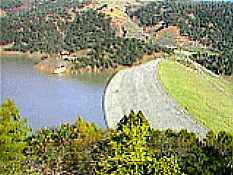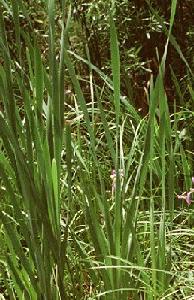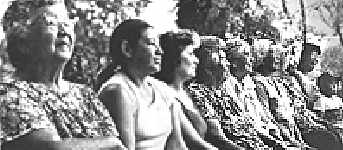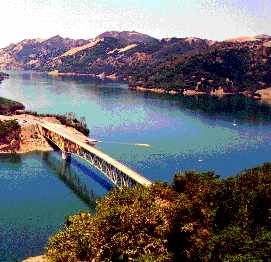 |
Lake Sonoma Dam Drowns Basket Plants |
|---|---|
| The valley wasn't rescued; only some plants. But the elder Pomo women, who had kept an art alive established an important principle. Living wild things of a still-living traditional cultural art are part of environmental impacts caused by land development. This principle may govern future Indian land preservations. It is giving birth to something new and extraordinary: the first recapture of Indian lands taken for park purposes. The park will be owned and managed by a colaition of small northern California tribes, so maybe this should be called an International public park. | |
|---|---|
| Wooly sedge (Carex languinosa), has long roots, which when split and cured are used as the weft or sewing stitch threads -- the pale buff -- in most California basketweaving. | |
"Not all streamsides have the proper conditions for growing bulrushes and sedges. It is necessary to find places along streams where the current is not too swift so that enough sandy soil has accumulated in low areas near the streamside to allow these plants to grow. You can come back every 3 years. This pruning of the sedge roots in the ground is actually good for the plants, preventing the roots from growing so thick they overuse the nutrients in the soil, and from growing into tangled masses that are so hard on basketweaving diggers! " |
 | "Digging for roots in the warm springtime gave a feeling of being part of the beautiful natural world. It was healthful and invigorating, while the delightful hours passed until it was time to pause and have a good bellyfilling picnic lunch of acorn meal mush, roots, tubers, and maybe a cooked rabbit or [musk]rat. All about, the birds were singing, and many interesting animals and insects could be watched, especially by children, who helped their mothers until they got tired." -- Elsie Allen, 1972 Suitable sedge plants, the long-rooted ones, do not grow in every wetland or streamside. As has been mentioned, Yosmite Miwok basketmakers trade for them, because the variety growing in Yosemite has roots too short to be conveniently used in basketry. Access to sedge and bulrush, whose split roots provide basket weft pattern colors from brown to deep, glossy black, has grown difficult, with increasing urban and agricultural devlopment. On of the last places California basketmakers could gather these plants was in the heart of the traditional Pomo homeland, along Dry Creek and the Warm Springs Valley, which fed into the Russian River, in Sonoma County. The U.S. Army Corps of Engineers undertook an orgy of dam-building after World War II, which drowned so much Indian land -- the Seneca Cold Springs longhouse (Kinzua Dam), Cochiti Pueblo, Ft. Berthold N.D. Mandan-Arikara-Hidatsa (Garrison diversion Dam),Tellico Dam (Chota sacred site, burial grounds, Cherokee homeland), Chemehuevi (Parker Dam) -- and many others in almost every state. The Army Corps of Engineers had planned a dam near the outlet of the basket plants valley, where a lake created primarily for irrigation water source and recreational purposes in the rich and tourist-oriented wine country of Sonoma County would drown all access to the one place where Pomo and other Native California basketweavers could still get the plants needed to continue the glorious tradition, which has been illustrated here. California archaeologists protested weakly, for this would also drown some old sites they were interested in -- traditional Pomo village and ceremonial centers not yet studied by their methods of concentration on the dead fragments of the past. What the archaeologists were -- are -- interested in, the dead past buried in time, is indicated by several studies they prepared for the Army Corps of Engineers, which show no indications of the fact that the greatest importance of the valley was of its living plants -- which they considered merely weeds -- to life of a still living art, vital to the culture in the past, present, and future: Bean, Lowell John, and Eugene G. Hirtle. The Mahilkaune Pomo and Their Neighbors: An Ethno-Historical Study of the Warm Springs Dam and Lake Sonoma Project, Sonoma County, California. Washington, D.C.: U.S. Army Corps of Engineers, 1974. Baumhoff, Martin A., and Robert I. Orlins. An Archaeological Assay on Dry Creek, Sonoma County, California. Contributions of the University of California Archaeological Research Facility, no. 40. Berkeley: University of California Department of Anthropology, 1979. But the basketweavers were alive, like the plants they needed, and the art they used them for. They compelled a different idea of cultural preservation. Not the dead past, but the living present and future. Not "wilderness" considered as a picturesque vacationland and outdoor zoo for a few remaining wild animals, but a place where people, the land, the climate and weather, plants and their long growth and seasonal changes are all together a part of a way of life. New things had been happening. There was the 1969-71 Indians of All Tribes occupation of Alcatraz, an abandoned federal prison island in San Francisco Bay. This led to several occupations by Pomo youth of abandoned military facilities -- one of them a CIA spy base, where they actually got the land for an Intertribal learning center. Coyote Valley was a Pomo reservation where the people had succeeded in buying 7 acres of land in the late 1800's, and hung onto it until losing it to mortgage foreclosure in 1928. Meanwhile, the Landless Indians Act was passed. 100 acres were bought for Coyote Valley band, but no one could live there because there was no water. Still in the late 1930's, the Depression was so bad some families moved onto this land and survived with small gardens. But in 1949, the Army Corps of Engineers planned a dam there which would expand Lake Mendocino and flood their land. By 1957, the last Pomo families were kicked off and that dam flooded the area. Because they no longer had any land to federally protect with reservation status, the Coyote Valley band was asutomatically terminated in 1958. But in 1976, they won a lawsuit started by another member of the of the litigation rights activist Knight family (see Elsie Allen's page and Pomo History). It was concluded that federal termination of the Coyote Valley reservation status -- just because it had been forcibly drowned -- was illegal. Coyote Valley band got reservation status back, though their land was still underwater. In 1979, they were able to buy 58 acres as a reservation, north of Ukiah in Redwood Valley. All of these actions -- the land and rights activism of the times, the occupations by Indian groups, the court action that succeded -- suggested to the basketmaking Pomo women that there might be something they could do to save the last generally accessible site of the necessary sedge plants, that was slated for drowing by the Army Corps of Engineers Warm Springs Dam. Elder Pomo women -- who had revived basketry, who were passing it to new generations -- and a generation of those who had become involved educationally in language and culture preservation, and land rights struggles took the lead in something quite new in cultural preservation: living plants were needed to continue a still-living art. Cultural preservation means those plants have to be able to go on living, or the art and the culture to which that art is central, will die. The photo below shows a group of several generations of Pomo basketweavers, from the eldest, Laura Somersal, to a very young boy, gathered at the site where the dam was to be built, to begin an inventory and environmental assessment of plants important for the living art. Not shown is Kathleen Smith, Hikhilakawana (Dry Creek) Pomo, tribal scholar and writer, whose efforts -- as Archaeology technician and coordinator for what became the Native American Advisory Council for the Warm Springs Cultural Resources Study -- recorded traditions and history of the to-be-drowned area, and helped to organize the elder women whose plant knowledge -- as used in the still-living art they practiced -- was extensive. |
 | |
Pomo weavers gathered in 1979 at Warm Springs Dam site to consult with Army Corps of Engineers on transplantation of sedge for weavers' continued use. Pictured from left to right are: Laura Somersal, Myrtle McKay Chavez, Lynn Cannon, Elsie Allen, Lucy Smith, Josephine Wright, Mabel McKay, and Jan Dempsey with her son, Damien. Photo by Rob Botier. Even after the women had formed the advisory committee and begun the collection and write-ups of information about the needed plants in the valley, it was hard to get the attention of academics, engineers, politicians. A "revision" of the site assessment, the to-be-drowned valley, published a year after after the women had begun their work, still reflects the study of a dead past angle of the academics: Bates, Craig D., and Martha J. Lee. Warm Springs Cultural Resources Study Revised Research Design, Investigation of Prehistoric Archaeological Sites. Rohnert Park, Calif.: California State University, Sonoma, Anthropological Studies Center, 1980. Not until the dam was well on its way to completion, and its closure, the upcoming land-drowing, had been scheduled, was the perspective of life -- a living art, living Indian people, living plants -- reflected in any of the "environmental and archaeological" studies made as required by law by the non-Indian experts. Another Pomo woman, and the legal action she started, might have had something to do with the U.S. Army Corps of Engineers' reluctant belated willingness to listen to the Indian women. Tillie Hardwick, member of the Pinoleville Pomo Rancheria, filed suit on behalf of the illegally terminated rancherias. This suit was won in 1983, resulting in restoration of federal protected status to whatever land was left -- sometimes nothing -- of the lands of 17 terminated rancherias. This approaching court success, as the case made its way through the federal courts and more small tribes joined it, led to the U.S. government realizing they should possibly cover themselves against legal assertion of Indian rights in the valley they were going to drown by the Warm Springs Dam, then nearing completion. This led to late, minor support for the Pomo women's basketmaker group: Peri, David W., Scott M. Patterson, Jennie L. Goodrich, and Richard Lerner. Ethnobotanical Mitigation: Warm Springs Dam, Lake Sonoma, California. San Francisco: U.S. Army Corps of Engineers, 1982. "Ethnobotanical mitigation" -- fancy phrase for a simple meaning: Save a few plants. There was no way to stop the dam. The women wanted to try to save the crucial plants, to replant them somewhere else where they would flourish, and where they would be -- as they grew into new stands -- available to Native basketmakers. It had to be both a suitable environment and a place these elder women -- most of whom lived in Mendocino and Lake Counties -- could easily get to, to dig roots. There had to be enough of the right quality streamside wetland to take care of the basketry needs of future generations, enough sedges so they could dig no more than a quarter of the plants every year, year after year on tro future generations. The women had help from Ya-Ka-Ama Pomo Learning Center, founded on an abandoned CIA spy base that Pomo people occupied in 1970 (see Elsie Allen's page). A Native plants nursery was founded there, as part of the basketry plants struggle. The Learning Center found a focus quite different from other cultural learning centers, something new. The Learning Center became a place for tradition-based environmental learning, and the saving of native plants considered (by the dominant society) useless weeds. A Native Plant nursery is now part of its efforts. But although the Army Corps of Engineers wanted to insure they wouldn't be sued in the future, their minor support in allowing the women to compile information about the necessary plants didn't extend providing any land to transplant them to -- just as Coyote Valley's 1976 lawsuit victory had won reservation status for their drowned land, but no land. The main help was donation of the use of a large tract of suitable streamside on private land of a non-Indian woman who had become involved in this struggle. There was some money from the U.S. government for transplanting sedges, and that was about it. The dam was completed and closed in 1983. The waters began to rise. The valley was fully drowned by 1985. Lake Sonoma is now what it was created for: benefit to large commercial agriculture and a big tourist attraction (the flood control purpose is the usual Corps of Engineers fake), greatly enhancing land values for local wealthy white grape-growers. | |
 |
Here's what the tourist association has to say about it: "Serves as a deterrent to disastrous floods, stores water for irrigation and municipalities, and creates a lake for recreation. The dam is 319 feet high, 3,000 feet long, and creates a lake with a capacity for 381,000 acre-feet (120 billion gallons) of water. Lake Sonoma extends 9 miles on Dry Creek and 4 miles on Warm Springs Creek." |
| More was accomplished than the saving of some useful little plants that the dominant society considers weeds, and that Indian women use to make enduring art. A principle was established: that environmental considerations need not be limited to recreation, and for Indian people need not be limited to burial grounds, ancient sacred sites, forgotten sources of potsherds and other dead relics. Where cultures are alive, and make an art of living things, this is an environmental consideration which is presently ignored by the law. But not by those women, who in fact did save something from the flood that drowned the valley in a lake to improve surrounding whites' proprty values. Coalitions were formed, groups and individuals learned to work together. Indian people in California began to feel they could offer leadewrship in new concepts of environmental preservation, land rstoration, and land stewardship in tune with ancient Native values. | |
